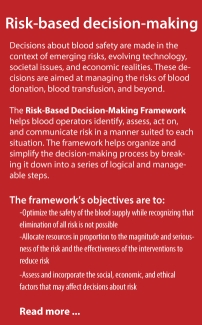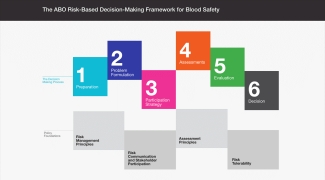Making decisions the right way – a global endeavour – Part 2
Wednesday, December 14, 2016 Jenny Ryan
Go back to Making decisions the right way - a global endeavour - Part 1
A risk-based decision-making analysis on babesia in Canada
Canadian Blood Services put babesia risk through the risk-based decision-making framework. We were curious about babesia risk and the experience of using the framework to determine a course of action. To find out more, we caught up with Dr. Margaret Fearon, medical director of microbiology at Canadian Blood Services. She is an expert in infectious diseases and conducts surveillance of bloodborne pathogens and emerging infectious threats to the blood supply.
Background on babesia — Q&A with Dr. Margaret Fearon
What is babesia?

Babesia microti (B. microti) is a tick-borne parasite that can infect red blood cells. Babesiosis is usually acquired from the bite of a tick (Ixodes scapularis), more commonly called the blacklegged tick. Usually, it causes mild flu-like symptoms, and many people are not even aware that they have had it.
However, it can be transmitted by transfusion. Blood product recipients may develop more severe disease with hemolytic anemia and kidney failure. Infections have been identified in U.S. blood donors particularly in the northeastern U.S.
Is babesia present in Canada?
The parasite appears to be in the very early stages of becoming established in ticks in Canada. The first reported case of babesiosis acquired in Canada was reported in 2013. It is still a rare disease in Canada.
How can a person get babesia?
People can get infected with the babesia parasite in several ways:
- Through the bite of an infected tick — during outdoor activities.
- Less commonly through a blood transfusion from a donor who has a babesia infection but does not have any symptoms.
How much of a risk is babesia compared with something we hear a lot about in the media like Zika?
Currently, in Canada the main risk for acquiring either Babesiosis or Zika virus infection is through travel to areas where they commonly occur. The risk within Canada is extremely low for both diseases. The mosquitos that transmit Zika virus are currently not found in Canada. The ticks that spread Babesiosis are present in parts of the country but at this point, very few of the ticks tested are positive for the babesia parasite.
How does Canadian Blood Services manage and monitor emerging risks like this?

We routinely conduct surveillance to monitor transmissible diseases in blood donors. We work with public health agencies to monitor the spread of infectious diseases, relevant to the blood supply, and we collaborate with other blood operators internationally.
We apply tools like the risk-based decision-making framework to ensure we have assessed and evaluated all aspects of risk.
What risk does babesia pose to the blood supply in Canada?
From a study we conducted in collaboration with Héma-Quebec in 2013, of almost 14,000 donors we found no positive donors. At that time, we concluded that there is currently a very low risk to the Canadian blood supply, based on our study and also information on Babesia prevalence in surveyed tick populations conducted by the Public Health Agency of Canada, National Microbiology Laboratory.
In 2016, we assessed Babesia using the risk-based decision-making framework. While we still consider the risk of babesiosis to Canada’s blood supply to be very low at the moment, it is important to remain vigilant and plan for changing levels of risk, should they occur. The risk analysis process has given us the opportunity to review possible options in advance of having to make decisions around an increasing threat. Although circumstances may change, this provides valuable information on which to base rational and cost effective mitigation strategies.
How do you feel the risk-based decision-making framework has helped in assessing this and other risks?
This framework provides a very organized approach to risk assessment and encourages the examination of different possible options to address the risk. It includes comprehensive information gathering, input from stakeholders, financial assessments, and ethical considerations. The team approach brings different expertise and experience to the table and provides a very comprehensive review and assessment of the risk.

The RBDM Framework helps organise and simplify the decision-making process by breaking it down into a series of logical and manageable steps. The Alliance of Blood Operators (ABO) — an international body comprised of blood service organizations from around the world, Canadian Blood Services among them — has built a unique framework to help blood service operators streamline this process and make responsible decisions that lead to the greatest good. Operational since 2015, many blood operators have used the risk-based decision-making framework for blood safety to make decisions around various aspects of blood collection, including donor eligibility factors, risk mitigation and testing protocols.
Read more
Making decisions the right way – a global endeavour – Part 1: an interview with Judie Leach Bennett
Canadian Blood Services – Driving world-class innovation
Through discovery, development and applied research, Canadian Blood Services drives world-class innovation in blood transfusion, cellular therapy and transplantation—bringing clarity and insight to an increasingly complex healthcare future. Our dedicated research team and extended network of partners engage in exploratory and applied research to create new knowledge, inform and enhance best practices, contribute to the development of new services and technologies, and build capacity through training and collaboration.
The opinions reflected in this post are those of the author and do not necessarily reflect the opinions of Canadian Blood Services nor do they reflect the views of Health Canada or any other funding agency.
Related blog posts
Dr. Sheila O’Brien knows the answer. She is the associate director, epidemiology and surveillance, working at Canadian Blood Services head office in Ottawa. Understanding and minimizing the infectious risks associated with blood transfusion is what she does each and every day.
Canadian Blood Services helped develop a unique framework for blood operators around the world to help improve and standardize the decision-making process when it comes blood safety.
